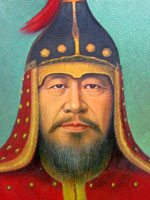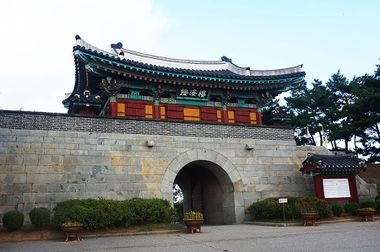GGHS 2019 Winter - Team 10
Write introduction about topic here.
목차
Team
| No. | Team Topic | Teacher | Role | Name (Korean) | No. of Students |
|---|---|---|---|---|---|
| 10 | Famous People and Historic Sites of Ganghwa (강화 유명인사 유적지) |
Margarita KICHUKOVA | Leader | 이하람 | 8 |
| Vice-Leader | 고바하 | ||||
| 김하영 | |||||
| 박진현 | |||||
| 한지민 | |||||
| 김도희 | |||||
| 박제이 | |||||
| 황예진 |
Topic
- Famous People and Historic Sites of Ganghwa
Introduction
Body
Yang Heon-soo
- the life story of Yang Heon-soo
1816 He was born in Yangpyeong. 1848 He was admitted tothe military service examination 1859 He was also assigned to Kapsan of Hamgyeong-do 1865 He was appointed as governor of Jeju. 1866 He was appointed to Dongbu Seungbu. He has become a captain of Jeongjoksanseong Fortress. 1866 French campaign against Korea happened 1875 he was appointed as a the Minister of Justice 1884 he was appointed to the minister of Works. 1888 Death
General Yang Heon-soo[2]
- Achievement (related to Ganghwa)
General Yang Heon-soo and Lee Yong-hee of Sunmujunggun’s Military Division led soldiers together with Lee Hyun-gyu of the Central Army to protect the Fort Sondolmok of Gwangseongjin. In 1866, French troops invaded Ganghwado Island. As a left-main commander, Yang headed about 500 soldiers and infiltrated the Jungjoksanseong. Yang Heon-soo chose to hide behind the walls of the fortress because his weapon performance was lower than that of the French army, considering the Joseon army's close firelock distance and the number of bullets they had left. Then he used the tactic of intensive fire when the French troops came to the castle. In other words, he fought a guerrilla war with the French Navy’s Colonel Olivier. On November 7, 160 French marines who were trying to attack the fortress led by Colonel Olivier, were driven to the brink of collapse by some 500 South Korean sailors. He was appointed asSeoul a deputy mayor. In addition, he was appointed Army Commander of Hwanghae in 1869. The crushing defeat in the Battle of Jungjoksanseong demoralized the French army, and in the end, French Admiral Rose decided to withdraw. According to the records of Joseon, six French soldiers were killed and 30 others wounded. On the other hand, French records show three dead and 35 wounded soldiers. In 2013, Seoul City designated Yang Heon-soo’s diary as a cultural property. Thanks to Yang Heon-soo, the documents and books kept in Jeongjok Mountain's archive inside Jungjoksanseong were protected from looting. In 1871, when he was serving as a soldier, Yang was in charge of conducting special tests for the selection of army officers every year as a way to encourage the new system to strengthen his defense. The participants were given preferential treatment as well as grain and cotton according to their grades. and he was appointed as a soldier for another year as such political achievements were recognized. The following year, he arrested and killed a group of pirates who were on the coast of Hwanghae.
Jungjok mountain fortress
{{문화유산정보 |대표명칭 = Jungjok mountain fortress |지정번호 = National Historic Site No.130 |지정명칭 = 강화 삼랑성 |한자명칭 = 江華 三郞城 |영문명칭 = Jungjok mountain fortress |주소 = San 41-1 Gilsang-myeon, Ganghwa-gun, Incheon |위도 = 37.632892, |경도 = 126.487163 |사진 = 1577832_image2_1.jpg
introduce
One of the famous historical sites in Ganghwa is Jeongjoksanseong Fortress, located at 222m above sea level in the southern part of Ganghwa Island. It was first built during the Three Kingdoms Period and then reconstructed by king Yeongjo of Joseon.During the dynasties of Goryeo and Joseon, it was the most important government complex to protect the outskirts of the capital city as well as the city of Hanyang. Gangwhado is often referred to as “the throat of Seoul”, and the Jeongjoksanseong Fortress is in such a critical position that it could be called “the brain of Gangwhado”.consists of five mountain peaks, and the fortress was built where their ridges and valleys merge. As the fortress wall was built along the topography of the mountain, the height difference between its northern and its southern part appears to be large.
purpose
The fortress is believed to have been first built by the kingdom of Baekje during the Three Kingdoms Period. At that time, it was not only a gateway to the Han River, but also played the role of a defense mechanism as a fortress with only two roads – one to the East and one to the South being navigational.
Configuration
Surrounded by steep cliffs, the fortress facilities include four gates to four corresponding inside fortresses, namely Dongmun (East Gate), Nammun (South Gate), Seomun (West Gate), and Bukmun (North Gate).A distinguishing feature of the South Gate is its gate tower, Jonghae-roo, while the North Gate was built as a hidden gate.Inside Jeongjoksanseong Fortress, there are other buildings such as Jeondeungsa Temple, Jeongjoksan Temple, Gunchang and Gungigoo Military Warehouses The most recognizable amongst the gates is the East Gate, which has a brick-lined arch built over its pillars, similar to the West Gate which is also arch-shaped.Inside the fortress, there is a temple believed to have been built during the Goryeo Dynasty.
War of historical significance
In 1866 when the French army invaded Ganghwado Island, a fierce battle between Korea and France took place here. In response to the French army that occupied the then Ganghwa branch of Byeonginyang in 1860, thousands of Korean soldiers were dispatched to Joseon’s Ganghwa Island.Fortress on November 7 after crossing the Ganghwa coast with some 500 soldiers. Upon receiving news of the Korean army's entry into the fortress, French admiral Rose sent Colonel Olivier to take over the fortress.When French troops finally approached the castle, they fired close shots, causing the death of six and the retreat of 35 wounded French soldiers. French officers suggested attacking Jeongjok Mountain again, but Commander Rose ordered the army to withdraw from Ganghwa Island on the grounds that it was not strong enough to subdue the fortress.The battle resulted in many casualties and a setback in the war, forcing French troops to withdraw from Ganghwa. To commemorate Yang Heon-soo's victory at the South gate, a memorial stone was erected at the site.
Eo Jae Yeon
- the life story of Eo Jae Yeon
1823 He was born. 1841 He passed the military service examination and became an Gongchungdobyungmajerdosa (commander of army). 1866 Byeongin Yangyo broke up and defended at Gwangseongbo. 1871 During Byeongin Yangyo, he was recommended to Samgunboo (the government office in charge of military affairs) and dispatched to Sunmoo-young as a general. 1871 During Shin Mi Yangyo in Gwangseongbo, he was killed by a gunshot wound by James Doherty. After his death, he was promoted to Byeongjopanseo Jisamgunbusa. (Leader of Byeongjo, which was in charge of military affairs.)

- Achievement (related to Ganhwa)
Shin mi Yangyo (United States-Korea War of 1871)
The war situation is not good when United States-Korea War of 1871 occurs, and the U.S. forces occupy Chojin and Deokjinjin and attack Gwangseongbo, the main quake. The 600-man veteran, who was on the defensive in Gwangseongjin, struggled on June 11 to fight a U.S. general offensive that took over Deokjinjin. As he is pushed from here to Son Dol Mok-dondae, General Eo Jae-yeon will prepare for the final battle with 350 soldiers under his command. The U.S. and Joseon troops will stage a fierce battle of hand-to-hand fight in Son Dol Mok-dondae. General Eo Jae-yeon fought against the U.S. on both sides of the water, but went into a field of a fierce fight and fought without backing down until the end, before being killed by the U.S. military sailor James Doherty's bayonet. In the battle, the Joseon military suffered a crushing defeat, with 53 soldiers killed, 100 killed and 20 captured. However, the U.S. military, which praised the Chosun soldiers for their persistent battles, politely burys the officers, including the officer's staff. In Joseon, he added a tribute to his brother, Eo Jae-soon, to his brother, General Eo Jae-yeon, to his military court, and erected a monument to the loyalty of the two brothers.
Gwangseongbo
Gwangseongbo 
지정 번호 Historic Site No. 227 지정일 지정 명칭 광성보 한자 명칭 廣城堡 영문 명칭 Gwangseongbo 분류 건립·제작 1658(Hyojong9) 주소 833 Deokseong-ri, Buleun-myeon, Ganghwa-gun, Incheon 위도 37.665267 경도 126.530094 웹사이트
In 1618 in the 10th year of the Gwanghaegun of the Joseon Dynasty, it was renovated and installed Gwangseongbo in 1656. it’s Dondae was bulit in 1679. Dondae of Odu, Hwado, Gwangseong and Odujeong artillery unit was belonged to it. It was rebuilt as a complete stone fortress in 1745 and the gate was also installed. Gwangseongbo was the fiercest battle of the time. On April 24, 1871, when U.S. Rogers led a fleet of 1,230 troops to invade upon demand for commerce, after the landing force occupied Chojijin and Deokjinjin, they deploy hand-to-hand fight in Gwangseongbo. After this battle, Anhaeru, Gwangseongdon, Son Dolmok, Youngudon, and the tomb of General Eo Jae yeon who died in the war were all repaired and contructed on the site of the site purificatiion. Gwangseongbo is currently designated as Historic Site.
Conclusion
We investigated General Eojae's Sinmiyang and General Yang Heon-soo's ByeonginYo, and explored the place where the war took place. As a result, these two wars were representative wars that led to the victory of Joseon as a key point of Ganghwado Island, and played a major role in promoting Ganghwado to the world. I felt that the history of Ganghwado has been revived through today's challenge of exploring people with interest in our own faults, or the strength of our friends' faults. Also, General Yang Hun-soo, who was visibly inferior, led the team to victory through perseverance, passion and cooperation, has become the driving force and strength base for us in the global camp. we think we should give a tribute to the two generals who contributed to the peace of the Joseon Dynasty.
Map(s)
Network Graph(s)
- SAMPLE: VH2018_부석사reference.lst
- YOUR TEAM GRAPH: GGHS2019W_Team10.lst
References

